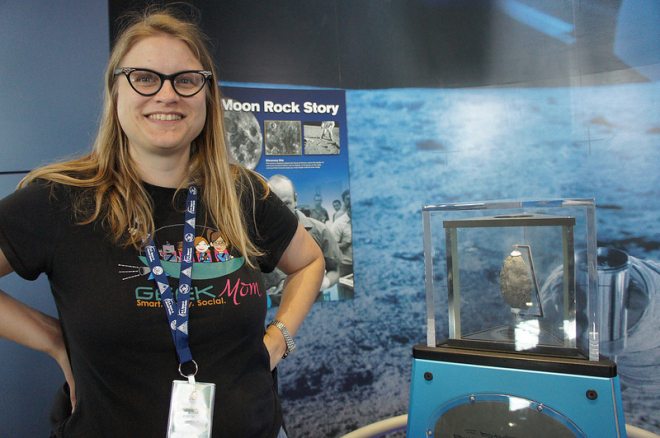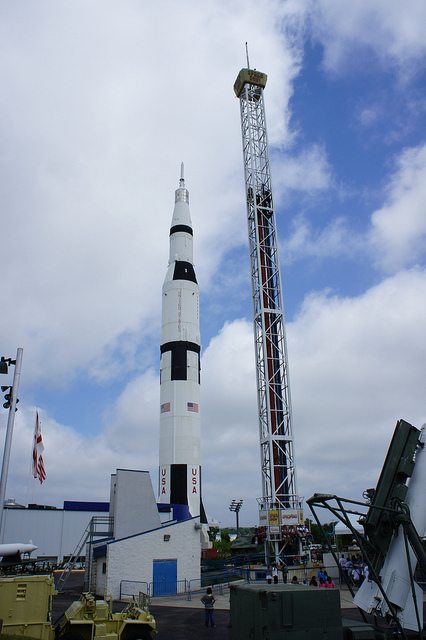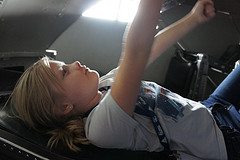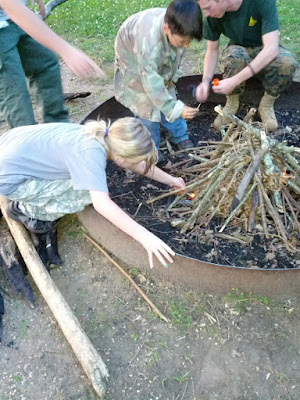
The summer hasn’t even really started, but I’m already declaring it to be the best summer, ever. This year I was invited to attend a parent and child weekend at Space Camp. (Full disclosure: “Invited” means I didn’t pay camp fees, but I still had to fund my own transportation to get there.)
Yes, this is the same Space Camp that, if you were like me, you dreamed about attending when you were a kid. I’m happy to report it’s every bit as awesome as you’d imagined it would be as a child, except for the part where a series of mishaps mean campers must go on a real space mission to save the planet from impending doom.
Space Camp is primarily funded by the state of Alabama and located at the US Space & Rocket Center in Huntsville near the Marshall Space Flight Center. Programs start for kids age 7 and up, and they’ve got camp sessions for kids, for families, for teachers, for corporate groups, and even for adults. There are also camp sessions designed specifically for Deaf or visually impaired students. There are camp sessions most of the year, but the popularity and price goes up in the summer. At full capacity, there could be up to 1000 simultaneous attendees.
The price range for child-only camp is around $750-$950, depending on the time of year, and the cost for family camp is about $850-$1250, depending on the number of family members. The camps include lodging and cafeteria food. There are additional charges for things like airport shuttle service or souvenir jumpsuits. Local residents can also attend day camp sessions.
Aviation Challenge
My daughter and I were there for a family version of the Aviation Challenge. There are several different tracts for Space Camp, but the biggest difference is between the Space Camp sessions, geared toward future mission specialists, and Aviation Challenge, geared toward future jet pilots and mission commanders with more of a military aviation feel. Aviation Challenge (AC) has separate bunker-style housing and separate training equipment, including a lake and forest area, but they make some use of the common Space Camp facilities as well. There’s also an area used by both AC and corporate confidence-building workshops named Area 51.

The Museum
We actually arrived the night before and stayed at a nearby hotel. There were no direct flights for us to Huntsville, and it seemed easier than spending the day flying. We ended up arriving before the official check-in time, but that just gave us more time to explore the USSRC museum.
The museum grounds include rockets and space-related equipment of all shapes and sizes, including a piece of Skylab. They’ve also got the Pathfinder, a full scale space shuttle mockup used by NASA. The museum even has rides. Pictured here is the Space Shot ride — note the size comparison with the rocket in the foreground. It’s one of those rides that takes you straight up and then pulls you straight down, very fast. The other outdoor ride is the G-Force, and it’s a spinning centrifuge type ride that I found extremely uncomfortable but my daughter loved. There are also a couple of indoor rides, including a temporary Apache helicopter simulation from the Air Force. It was the only ride that had an extra charge.
Inside the Davidson Center for Space Exploration is a massive Saturn V rocket. The building was actually built around the rocket to keep it from the elements, but it became a great focal point for the museum. Apparently they did not foresee the need to also protect it from destructive people. Also housed in the Davidson center is the moon rock, tons of items used in early space exploration, and interactive displays that let you climb in and experience the claustrophobia of Saturn missions for yourself.

In addition to the Davidson Center permanent displays, there’s a giant rock climbing wall decorated to look like a Mars landscape, an IMAX movie theater, daily lecture demonstrations about the International Space Station, and traveling displays. The temporary display during our visit was on Wernher von Braun.
The museum was worth the trip by itself if you’re in the area. (The price for separate museum admission is $20.)
After we had a chance to explore the museum and eat lunch, we checked in for the start of camp. We were given matching Aviation Challenge t-shirts and badges, and later on we got an “Aircrew Checklist,” which was a spiral bound book that went over all the camp lessons, provided additional info, and allowed space for a journal. My 10 year old started journaling about her trip right away, and she’s not normally a willing writer, so score another victory for Space Camp.
Living Quarters

As I mentioned earlier, AC has separate bunker-style living quarters. They’re expected to fold hospital corners on their sheets and have morning inspections from counselors. (Hey, they wanted a realistic military experience.) Family AC campers skip that and stay in the Space Camp Habitation Units, so families can be grouped together. The Habitation Unit buildings are meant to look like they belong on a space station, while the furniture is built to withstand lots of kids. Our unit consisted of seven beds, four of which were upper bunks. There aren’t any locks on the doors, so valuables went into lockers, and the bathroom was down the hall.

Code Names
Our group was very small (one of the reasons they had space to invite GeekMom) and consisted of only three family groups. It worked out really well. We didn’t have to spend a lot of time waiting for turns to try things, and we were very flexible with our plans. Everyone was assigned code name, which is much easier than sorting out a lot of common-first-name-last-initial sets. Counselors already had code names, and they used them with each other. Real astronauts and aviators get code names in the field, so it’s appropriate, and it makes a great ice-breaker. Our group consisted of camp counselor Shaggy and attendees: MC², Hubble, Splenda, Squirt, Butterfly, Chopsticks, and me – Scifi.
Spinning and Flying
The counselors I talked to seemed to be rather biased towards the Aviation Challenge side of camp. They do get some really cool stuff. We climbed not one but two walls while we were there. One wall is a “Mars” climbing experience in the museum, and the other was a proper outdoor climbing wall requiring teammates on belay. Only one of us made it to the top, and it wasn’t me. In the summer they’ve also got a lake for water activities, including zip lines, and water crash and rescue missions. We were just one week too early for that, so they hadn’t chlorinated the water yet.

The AC side focuses a lot on jet simulator training. We each sat in the cockpit of networked F/A 18 simulator jets and learned different skills. On Friday, we learned how to take off and land a jet. On Saturday, we learned how to bomb targets, how to dog fight, and how to navigate. On Sunday, we went on more team missions against the enemy. In case you were wondering, these skills do transfer to video games. My daughter and I totally rocked at IL-2 Sturmovik: Birds of Prey when we got back, and we’re going to have to add a few more games and dongles to our library.
Now it’s not all video games. We also learned flight theory. My daughter surprised us all by describing Bernoulli’s principle fairly accurately, although she didn’t know the name for the concept. Apparently she’d learned it from watching the Magic Schoolbus. I knew the TV made a great babysitter! That aside, the lessons and activities really dovetailed together, and I’d say we all came back with a better understanding of both the skills required to pilot a fighter jet and the physics behind flight.
We also learned a lot about motion and spinning. Pilots need to have a healthy understanding of the vestibular system and why it can’t always be trusted. We learned about sensory illusions with a spinning chair to illustrate the point.
Also, forget about the G-Force ride at the museum. The Aviation Challenge has a military grade centrifuge. They don’t spin kids around at the same speeds they do in the military, but this centrifuge contained some of the same safety mechanisms. In order to get it started, my daughter and I had to push on a sequence of buttons at the same time. (Sadly, it took us three tries.) To keep it going, we both had to push a button every few seconds (a dead man’s switch) to verify that we were conscious. No, we did not pass out, but I did feel about four times my body weight pressed against my arm when we spun.
This was an amazing experience I’ll probably never have again, and I have to give a shout out to Shaggy for taking the time to convince my daughter to give it a try. Camp should be about taking risks and trying new things, and we did both.
Survival Skills

Part of the AC curriculum was to learn some basic survival skills. While you’ll probably want to follow the opposite of some of their advice for hiding a tent if you haven’t crashed your jet behind enemy lines, the training was still fascinating and informative. If you have to guess which type of berry to eat in a forest, did you know an aggregate berry is the safest choice?
The camp also included training on orienteering with a compass (the compasses were a bit shot, so we went with an iPhone app).
We also had a unit on fire building. This, of course, was very fascinating to my 10 year old, and I was actually a bit relieved to have people with experience setting and maintaining fires let her participate in that process. I also learned a thing or two about different fire building styles. Did you know a log cabin arrangement is great for cooking foods?
Missions
Now it wouldn’t be a Space Camp, if you didn’t have some missions. In the case of Aviation Challenge, those missions are military. On Saturday night, we went on a bombing raid in our jet simulators. Then we put on some old surplus BDUs and went to build our fire.
After our fire was built and the sun had set, we played a game called Blitzkrieg. We each were given five poker chips. The goal of the game was to belly crawl through the woods to deposit the chips into guarded buckets. If the counselor caught you moving, you had to surrender a chip. They’d alternate between obvious movement and sneak attacks, so evasion was pretty tricky. It’s extra fun when it’s muddy, but we got pretty dirty without it. And then we finished up with s’mores. (Splenda volunteered to maintain the fire while we played in the woods. She was pregnant, so no belly crawls for her.)
Originally Sunday had been scheduled for fire building, but we’d combined a few activities the night before. Good thinking, because it ended up raining all morning. We went on extra bombing missions instead.
Safety
I was impressed with how safety-minded the camp was. With thousands of kids every summer, you’d really have to think about it, but there wasn’t a ride, mission, or lesson where I didn’t feel like they’d thought this thing through. There were functioning safety latches and seat belts on the equipment, and all the adults looked like they were paying attention and going through mental checklists. I’m sure a kid determined for trouble would find a way to get there, but I’d feel comfortable sending my child by herself.
Graduation
On Sunday, we “graduated” with a session of family Space Camp. We received certificates and a group photo and said goodbye and thanks to all the fantastic campers and counselors we’d met. Our flight was later, so we had most of the afternoon to revisit the museum. I let my daughter convince me to ride on the Space Shot with her before we left, and then we both agreed to never do that again.
What we didn’t agree to never do again was go to Space Camp. I’ve got to figure out some transportation logistics, but I’m definitely saving my pennies to send her back. Next year could be the best summer, ever.


